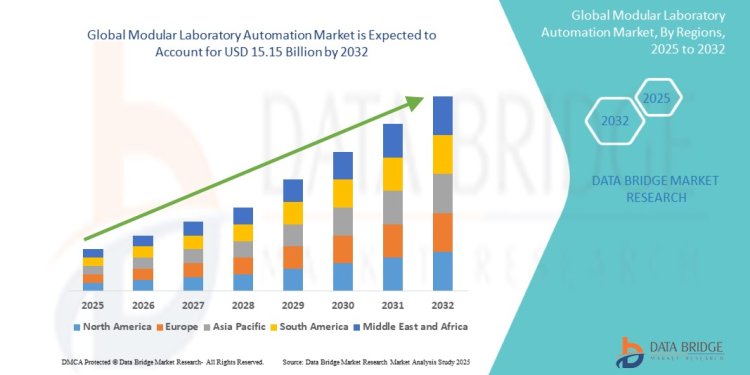Modular Laboratory Automation: Transforming Scientific Research
The global modular laboratory automation market size was valued at USD 8.98 billion in 2024 and is projected to reach USD 15.15 billion by 2032, with a CAGR of 6.76% during the forecast period of 2025 to 2032.

Introduction
In the rapidly evolving landscape of scientific research and diagnostics, automation has become a cornerstone of efficiency and precision. Among the various forms of automation, modular laboratory automation stands out as a flexible, scalable, and cost-effective solution. By integrating modular components, laboratories can customize workflows, enhance productivity, and streamline operations without requiring a complete infrastructure overhaul. This article explores the significance of modular laboratory automation, its benefits, components, applications, challenges, and future trends.
The Significance of Modular Laboratory Automation
Modular laboratory automation refers to the use of adaptable, interchangeable systems to automate various laboratory processes. Unlike rigid automation systems that require extensive installation and customization, modular automation allows for seamless integration of different components, making it an attractive option for laboratories with evolving needs. This approach is particularly beneficial for research institutions, clinical laboratories, and pharmaceutical companies seeking to improve efficiency without compromising flexibility.
Benefits of Modular Automation in Laboratories
-
Scalability and Flexibility
-
Laboratories can start with a few automated modules and expand as needed.
-
Enables customization based on specific research or diagnostic requirements.
-
-
Cost-Effectiveness
-
Reduces the need for extensive upfront investments in fixed infrastructure.
-
Minimizes downtime and labor costs associated with manual operations.
-
-
Enhanced Accuracy and Reproducibility
-
Reduces human error in sample handling and data collection.
-
Ensures consistent results across multiple experiments and diagnostic tests.
-
-
Improved Workflow Efficiency
-
Accelerates sample processing and analysis.
-
Optimizes the use of laboratory space by integrating compact, modular units.
-
-
Adaptability to Evolving Technologies
-
Facilitates easy integration of new automation tools, robotics, and AI-driven analytics.
-
Key Components and Technologies
-
Automated Sample Handling Systems
-
Robotic arms and pipetting systems that automate sample preparation and transfer.
-
-
Modular Liquid Handling Workstations
-
Precision liquid dispensers for chemical and biological sample analysis.
-
-
Automated Storage and Retrieval Systems
-
Smart freezers and incubators that store and manage samples efficiently.
-
-
Data Integration and Laboratory Information Management Systems (LIMS)
-
Software solutions that streamline data collection, storage, and analysis.
-
-
AI and Machine Learning Integration
-
Intelligent algorithms that enhance data processing and decision-making in laboratory workflows.
-
Applications in Various Scientific Fields
-
Clinical Diagnostics
-
Automating blood tests, genetic screenings, and infectious disease diagnostics.
-
-
Pharmaceutical Research and Development
-
Drug discovery, high-throughput screening, and quality control testing.
-
-
Biotechnology and Genomics
-
DNA sequencing, PCR automation, and protein analysis.
-
-
Food Safety and Environmental Testing
-
Detecting contaminants in food, water, and air samples.
-
Challenges and Considerations
-
Initial Implementation Costs
-
While modular automation is cost-effective in the long run, initial setup expenses can be significant.
-
-
Compatibility and Integration Issues
-
Ensuring that modular components work seamlessly with existing systems.
-
-
Training and Adaptation
-
Laboratory personnel require training to operate and maintain automated systems effectively.
-
-
Data Security and Compliance
-
Ensuring compliance with industry regulations such as FDA, HIPAA, and ISO standards.
-
Future Trends and Innovations
-
AI-Powered Automation
-
Predictive analytics and real-time decision-making in laboratory processes.
-
-
Miniaturized and Portable Laboratory Modules
-
Compact and mobile automation solutions for on-site testing and diagnostics.
-
-
Cloud-Based Data Management
-
Real-time data sharing and remote monitoring of laboratory workflows.
-
-
Collaborative Robotics (Cobots)
-
Enhancing human-machine collaboration in laboratory settings.
-
Source:- https://www.databridgemarketresearch.com/reports/global-modular-laboratory-automation-market
Conclusion
Modular laboratory automation is revolutionizing the way scientific research and diagnostics are conducted. Its scalability, efficiency, and adaptability make it an indispensable asset for laboratories looking to optimize workflows and enhance precision. As technology continues to advance, modular automation will play a crucial role in shaping the future of scientific discovery and healthcare innovation.
Other Trending Reaports:-
Global Venlafaxine Market - Industry Trends and Forecast to 2029
https://www.databridgemarketresearch.com/reports/global-venlafaxine-market
Global Memantine Market - Industry Trends and Forecast to 2029
https://www.databridgemarketresearch.com/reports/global-memantine-market
Global Online On-Demand Home Services Market Size, Share, and Trends Analysis Report – Industry Overview and Forecast to 2031
https://www.databridgemarketresearch.com/reports/global-online-on-demand-home-services-market
Global Oil and Gas Pipes Market – Industry Trends and Forecast to 2031
https://www.databridgemarketresearch.com/reports/global-oil-and-gas-pipes-market
Global Animal Wound Care Market – Industry Trends and Forecast to 2030
https://www.databridgemarketresearch.com/reports/global-animal-wound-care-market
Global Makeup Tools Market - Industry Trends and Forecast to 2028
https://www.databridgemarketresearch.com/reports/global-makeup-tools-market
Global Farm Automated Weather Stations Market – Industry Trends and Forecast to 2028
https://www.databridgemarketresearch.com/reports/global-farm-automated-weather-stations-market
Global Chylomicronemia Market - Industry Trends and Forecast to 2028
https://www.databridgemarketresearch.com/reports/global-chylomicronemia-market
Global Connected Enterprise Market – Industry Trends and Forecast to 2028
https://www.databridgemarketresearch.com/reports/global-connected-enterprise-market
Global Food Stabilizers Market – Industry Trends and Forecast to 2028
https://www.databridgemarketresearch.com/reports/global-food-stabilizers-market

What's Your Reaction?

















.jpg)
.jpg)

